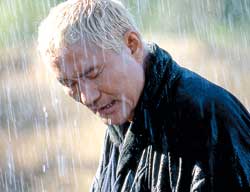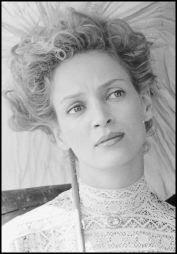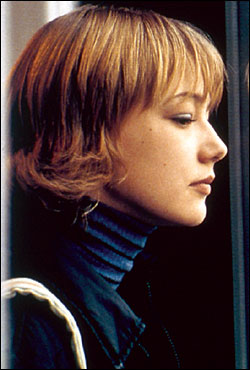In new hands, The Blind Swordsman: Zatoichi (which opens Friday, Aug. 6, at the Metro and Uptown), that staple of Japanese film and television from the ’60s through the ’90s, has been dusted off and given a good shaking. It emerges fresh, boisterous, and irresistible, thanks to the unmistakable stamp of its writer, director, editor, and star, Takeshi “Beat” Kitano.
In Japan’s feudal past, Zatoichi, the blind masseur, inveterate gambler, and defender of the needy, is faster with his secret blade than Zorro, more humble than Peter Parker. As reconfigured by Kitano, he’s also acutely attuned to the pulses of everyday village life—hammering, hoeing, chopping wood. As he hears the cadenced stroke of a hoe in the field, we see the movements edited into a mini-montage of upraised arms and striking tools, and hear these grunts and clomps become part of the film’s unique sound design.
The action comes with the usual gobbets of blood that define the franchise—although with Kitano, the bloodletting is so fast it’s almost subliminal. There’s also inevitably a comic twist: In the rush to get at Zatoichi, for example, one of a gang of swordsmen accidentally slices up one of his own guys instead.
Subverting expectation has always delighted Kitano; it’s what turned his 1997 landmark Hana-Bi (aka Fireworks) from cop fare into the small, bittersweet masterpiece that it is. Here, after witnessing the local thugs of gang boss Ginzo (Ittoku Kishibe) strong-arming the impoverished villagers for more protection money, the traveling Zatoichi is taken home by Aunt O-Ume, a woman with Eileen Heckart cheekbones and depths of experience. Although she warns him sternly, “No funny stuff,” the next sounds we hear are rhythmic groans. Then, in a high-angle shot, we see Zatoichi above her . . . giving a massage. It’s a Kitano gotcha! You can almost hear him chortle.
A showdown between Zatoichi and Ginzo is a given; less classic is one of the subplots involving a pair of sweet, sister geishas who arrive at the village with a deadly revenge agenda (quite separate from their gender agenda). An extra layer of tension comes as we meet the noble, masterless ronin Hattori (Tadanobu Asano) and realize that only his wife’s grave illness has brought him low enough to work for the corrupt Ginzo. (Just past 30, the tall, charismatic Asano is already a veteran of 30-some films ranging from the gentle Mabarosi to ones that put him on a recent Asia-edition Time cover, as “Japan’s favorite ultraviolent, overmedicated son.” Oh, those undermedicated Time writers.) Both plot strands are perfectly clear, thanks to Kitano’s practice of introducing characters, then quick-sketching their backgrounds in flashback.
By the film’s irrepressible finish—a sort of 19th-century Stomp, where all but the dead join a village celebration, led by a daredevil dance group known as the Stripes—we realize that Kitano’s sound design has been building toward this gala finale all the while. (Tap dancing in clogs? You have to see the Stripes to believe it.)
Over the years, Kitano has honed his persona as a taciturn enigma, dangerous to turn your back on—and that was before he had a sword-cane in his hand. Now, at 57, his hair dyed white-blond, his scarred, weathered face nearly impassive, these qualities make him Zatoichi incarnate. And his casting of the remarkable Asano, in every way his physical opposite yet with equal presence, gives their inevitable duel real poignancy and consequence. Making Zatoichi was reportedly much tougher than Kitano imagined, so this may be a first and only. You can only hope not.








